Related Research Articles
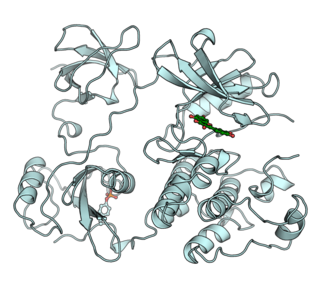
A tyrosine kinase is an enzyme that can transfer a phosphate group from ATP to the tyrosine residues of specific proteins inside a cell. It functions as an "on" or "off" switch in many cellular functions.
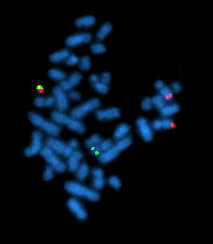
The Philadelphia chromosome or Philadelphia translocation (Ph) is a specific genetic abnormality in chromosome 22 of leukemia cancer cells. This chromosome is defective and unusually short because of reciprocal translocation, t(9;22)(q34;q11), of genetic material between chromosome 9 and chromosome 22, and contains a fusion gene called BCR-ABL1. This gene is the ABL1 gene of chromosome 9 juxtaposed onto the breakpoint cluster region BCR gene of chromosome 22, coding for a hybrid protein: a tyrosine kinase signaling protein that is "always on", causing the cell to divide uncontrollably by interrupting the stability of the genome and impairing various signaling pathways governing the cell cycle.
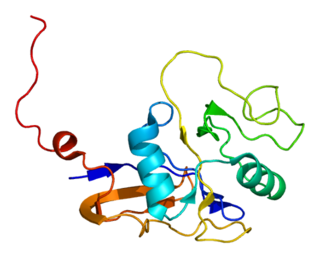
The CD44 antigen is a cell-surface glycoprotein involved in cell–cell interactions, cell adhesion and migration. In humans, the CD44 antigen is encoded by the CD44 gene on chromosome 11. CD44 has been referred to as HCAM, Pgp-1, Hermes antigen, lymphocyte homing receptor, ECM-III, and HUTCH-1.
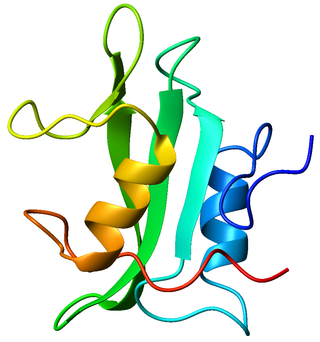
Lck is a 56 kDa protein that is found inside specialized cells of the immune system called lymphocytes. The Lck is a member of Src kinase family (SFK) and is important for the activation of T-cell receptor (TCR) signaling in both naive T cells and effector T cells. The role of Lck is less prominent in the activation or in the maintenance of memory CD8 T cells in comparison to CD4 T cells. In addition, the constitutive activity of the mouse Lck homolog varies among memory T cell subsets. It seems that in mice, in the effector memory T cell (TEM) population, more than 50% of Lck is present in a constitutively active conformation, whereas less than 20% of Lck is present as active form in central memory T cells. These differences are due to differential regulation by SH2 domain–containing phosphatase-1 (Shp-1) and C-terminal Src kinase.

Bruton's tyrosine kinase, also known as tyrosine-protein kinase BTK, is a tyrosine kinase that is encoded by the BTK gene in humans. BTK plays a crucial role in B cell development.

Tyrosine-protein kinase SYK, also known as spleen tyrosine kinase, is an enzyme which in humans is encoded by the SYK gene.

B-lymphocyte antigen CD19, also known as CD19 molecule, B-Lymphocyte Surface Antigen B4, T-Cell Surface Antigen Leu-12 and CVID3 is a transmembrane protein that in humans is encoded by the gene CD19. In humans, CD19 is expressed in all B lineage cells. Contrary to some early doubts, human plasma cells do express CD19, as confirmed by others. CD19 plays two major roles in human B cells: on the one hand, it acts as an adaptor protein to recruit cytoplasmic signaling proteins to the membrane; on the other, it works within the CD19/CD21 complex to decrease the threshold for B cell receptor signaling pathways. Due to its presence on all B cells, it is a biomarker for B lymphocyte development, lymphoma diagnosis and can be utilized as a target for leukemia immunotherapies.

Proto-oncogene c-KIT is the gene encoding the receptor tyrosine kinase protein known as tyrosine-protein kinase KIT, CD117 or mast/stem cell growth factor receptor (SCFR). Multiple transcript variants encoding different isoforms have been found for this gene. KIT was first described by the German biochemist Axel Ullrich in 1987 as the cellular homolog of the feline sarcoma viral oncogene v-kit.

Cluster of differentiation antigen 135 (CD135) also known as fms like tyrosine kinase 3, receptor-type tyrosine-protein kinase FLT3, or fetal liver kinase-2 (Flk2) is a protein that in humans is encoded by the FLT3 gene. FLT3 is a cytokine receptor which belongs to the receptor tyrosine kinase class III. CD135 is the receptor for the cytokine Flt3 ligand (FLT3L).

Tyrosine-protein kinase JAK3 is a tyrosine kinase enzyme that in humans is encoded by the JAK3 gene.
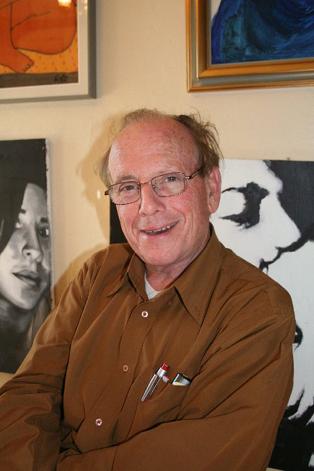
Alexander Levitzki is an Israeli biochemist who is a professor of biochemistry at the Alexander Silberman Institute of Life Sciences, the Hebrew University of Jerusalem.

Proto-oncogene tyrosine-protein kinase Src, also known as proto-oncogene c-Src, or simply c-Src, is a non-receptor tyrosine kinase protein that in humans is encoded by the SRC gene. It belongs to a family of Src family kinases and is similar to the v-Src gene of Rous sarcoma virus. It includes an SH2 domain, an SH3 domain and a tyrosine kinase domain. Two transcript variants encoding the same protein have been found for this gene.
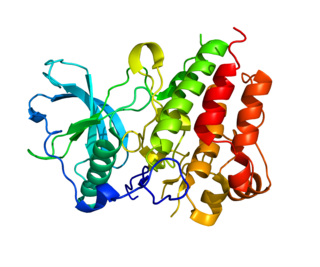
Colony stimulating factor 1 receptor (CSF1R), also known as macrophage colony-stimulating factor receptor (M-CSFR), and CD115, is a cell-surface protein encoded by the human CSF1R gene. CSF1R is a receptor that can be activated by two ligands: colony stimulating factor 1 (CSF-1) and interleukin-34 (IL-34). CSF1R is highly expressed in myeloid cells, and CSF1R signaling is necessary for the survival, proliferation, and differentiation of many myeloid cell types in vivo and in vitro. CSF1R signaling is involved in many diseases and is targeted in therapies for cancer, neurodegeneration, and inflammatory bone diseases.
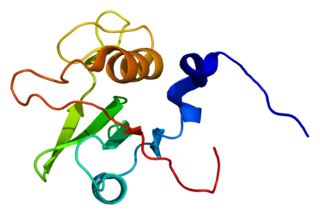
Tyrosine-protein kinase Fes/Fps also known as proto-oncogene c-Fes/Fps is an enzyme that in humans is encoded by the FES gene. FES was originally cloned as a retroviral oncogene from feline (v-FES) and avian (v-FPS) sarcomas. This triggered the subsequent identification and cloning of the cellular FES (c-FES) genes in birds and mammals.

Proto-oncogene serine/threonine-protein kinase Pim-1 is an enzyme that in humans is encoded by the PIM1 gene.

Tyrosine-protein kinase receptor UFO is an enzyme that in humans is encoded by the AXL gene. The gene was initially designated as UFO, in allusion to the unidentified function of this protein. However, in the years since its discovery, research into AXL's expression profile and mechanism has made it an increasingly attractive target, especially for cancer therapeutics. In recent years, AXL has emerged as a key facilitator of immune escape and drug-resistance by cancer cells, leading to aggressive and metastatic cancers.
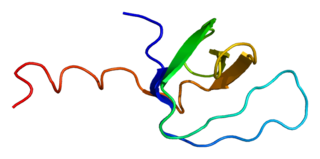
Tyrosine-protein kinase Tec is a tyrosine kinase that in humans is encoded by the TEC gene. Tec kinase is expressed in hematopoietic, liver, and kidney cells and plays an important role in T-helper cell processes. Tec kinase is the name-giving member of the Tec kinase family, a family of non-receptor protein-tyrosine kinases.
Interleukin-28 receptor is a type II cytokine receptor found largely in epithelial cells. It binds type 3 interferons, interleukin-28 A, Interleukin-28B, interleukin 29 and interferon lambda 4. It consists of an α chain and shares a common β subunit with the interleukin-10 receptor. Binding to the interleukin-28 receptor, which is restricted to select cell types, is important for fighting infection. Binding of the type 3 interferons to the receptor results in activation of the JAK/STAT signaling pathway.

Tyrosine-protein kinase transmembrane receptor ROR1, also known as neurotrophic tyrosine kinase, receptor-related 1 (NTRKR1), is an enzyme that in humans is encoded by the ROR1 gene. ROR1 is a member of the receptor tyrosine kinase-like orphan receptor (ROR) family.

Anthony Rex Hunter is a British-American biologist who is a professor of biology at the Salk Institute for Biological Studies and the University of California San Diego. His research publications list his name as Tony Hunter.
References
- 1 2 3 4 5 Vogt-James, Mirabai (August 3, 2015). "The 2015 AQACR Clowes Memorial Award for Outstanding Achievement in Basic Cancer Research". Cancer Immunology Research. 3 (8): 846–848. doi: 10.1158/2326-6066.CIR-15-0142 . PMID 26242762.
- ↑ "President's Cancer Panel".
- ↑ Witte ON, Dasgupta A, Baltimore D (February 28, 1980). "Abelson murine leukemia virus protein is phosphorylated in vitro to form phosphotyrosine". Nature. 283 (5750): 826–831. Bibcode:1980Natur.283..826W. doi:10.1038/283826a0. PMID 6244493. S2CID 4239008.
- ↑ Konopka JB, Watanabe SM, Witte ON (July 1984). "An alteration of the human c-abl protein in K562 leukemia cells unmasks associated tyrosine kinase activity" (PDF). Cell. 37 (3): 1035–42. doi:10.1016/0092-8674(84)90438-0. PMID 6204766. S2CID 34525263.
- ↑ Tsukada S; Saffran DC; Rawlings DJ; Parolini O; Allen RC; Klisak I; et al. (January 29, 1993). "Deficient expression of a B-cell cytoplasmic tyrosine kinase in human X-linked agammaglobulinemia". Cell. 72 (2): 279–90. doi:10.1016/0092-8674(93)90667-f. PMID 8425221. S2CID 32339052.
- ↑ Rawlings DJ; Scharenberg AM; Park H; Wahl MI; Lin S; Kato RM; et al. (February 9, 1996). "Activation of Btk by a phosphorylation mechanism initiated by src family kinases". Science. 271 (5250): 822–5. Bibcode:1996Sci...271..822R. doi:10.1126/science.271.5250.822. PMID 8629002. S2CID 42666246.
- ↑ "SU2C Scientific Research Teams, Owen N. Witte, M.D." Stand Up To Cancer.
- 1 2 "Owen N. Witte, MD | Class of 2014". American Association for Cancer Research.
- ↑ Reiter, R.E.; Gu, Z.; Watabe, T.; Thomas, G.; Szigeti, K.; Davis, E.; Wahl, M.; Nisitani, S.; Yamashiro, J.; Le Beau, M.M.; Loda, M.; Witte, O.N. (February 17, 1998). "Prostate stem cell antigen: A cell surface marker overexpressed in prostate cancer". Proceedings of the National Academy of Sciences. 95 (4): 1735–40. Bibcode:1998PNAS...95.1735R. doi: 10.1073/pnas.95.4.1735 . PMC 19171 . PMID 9465086.
- ↑ Goldstein, A.S.; Huang, J.; Guo, C.; Garraway, I.P.; Witte, O.N. (July 30, 2010). "Identification of a cell-of-origin for human prostate cancer". Science. 329 (5991): 568–71. Bibcode:2010Sci...329..568G. doi:10.1126/science.1189992. PMC 2917982 . PMID 20671189.
- ↑ Lee JK, Phillips JW, Smith BA, Park JW, Stoyanova T, Clark PM, Baertsch R, Sokolov A, Meyerowitz JG, Mathis C, Cheng D, Stuart JM, Gustafson WC, Huang J, Witte ON (April 11, 2016). "N-Myc drives small cell neuroendocrine carcinoma initiated from human prostate epithelial cells". Cancer Cell. 29 (4): 536–547. doi:10.1016/j.ccell.2016.03.001. PMC 4829466 . PMID 27050099.
- ↑ "American Association for Cancer Research". AACR.org.
- ↑ "The 2014 Rowley Prize is awarded to Dr Owen N. Witte". cml-foundation.org.
- ↑ Vogt-James, Mirabai. "UC regents appoint Dr. Owen Witte University Professor". UCLA Newsroom.
- ↑ "AACR Announces 2024 Scientific Achievement Award Recipients". American Association for Cancer Research (AACR). Retrieved 2024-03-01.